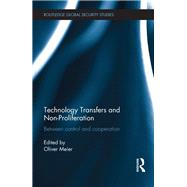- ISBN: 9780415535809 | 0415535808
- Cover: Hardcover
- Copyright: 8/22/2013
This edited volume examines the issue of the proliferation of dual-use technology and the efforts of the international community to control these technologies. Preventing the misuse of dual-use technologies i.e. information, materials and equipment that can be used for both peaceful and hostile purposes is an old problem which needs to be addressed more urgently than ever. Threats of attacks with weapons of mass destruction from terrorists have grown dramatically since the attacks of September 11, 2001. At the same time, new state-sponsored programs to develop nuclear, biological or chemical weapons of mass destruction (WMD) show that proliferation is an increasing threat. The diffusion of dual-use technologies as an inevitable side-effect of globalization, and the problem of secondary proliferation (the exchange of dual-use technologies between states that do not belong to the group of traditional technology holders) and the accelerating speed of technological advances have greatly complicated non-proliferation efforts. The three multilateral regimes to control nuclear, biological and chemical weapons, based on the Nuclear Nonproliferation Treaty (NPT), the Chemical Weapons Convention (CWC) and the Biological Weapons Convention (BWC) as well as the associated export control regimes Nuclear Suppliers Group (NSG) and Australia Group (AG) therefore are at the core of the international non-proliferation efforts.Yet, the NPT, CWC and BWC do not only contain obligations related to the control of dual-use technologies but also require member-states to facilitate the peaceful uses of such technologies. Such cooperative measures, aimed at promoting the exchange of dual-use technologies, can in themselves increase the dangers of misuse. Generally speaking, technology holders from industrialized countries tend to emphasise the control aspects of non-proliferation efforts while developing countries highlight the need for cooperation on peaceful purposes. This tension is at the core of the book which will analyse how these dilemmas of control vs. cooperation can be best tackled, with a view to strengthening just, equitable and effective global non-proliferation regimes. This book will be of much interest to students of weapons proliferation, arms control, global governance, international organisations and international security.






